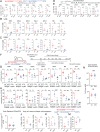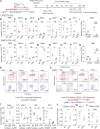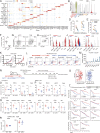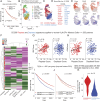Targeting CD206+ macrophages disrupts the establishment of a key antitumor immune axis
- PMID: 39601781
- PMCID: PMC11602655
- DOI: 10.1084/jem.20240957
Targeting CD206+ macrophages disrupts the establishment of a key antitumor immune axis
Abstract
CD206 is a common marker of a putative immunosuppressive "M2" state in tumor-associated macrophages (TAMs). We made a novel conditional CD206 (Mrc1) knock-in mouse to specifically visualize and/or deplete CD206+ TAMs. Early depletion of CD206+ macrophages and monocytes (Mono/Macs) led to the indirect loss of conventional type I dendritic cells (cDC1), CD8 T cells, and NK cells in tumors. CD206+ TAMs robustly expressed CXCL9, contrasting with stress-responsive Spp1-expressing TAMs and immature monocytes, which became prominent with early depletion. CD206+ TAMs differentially attracted activated CD8 T cells, and the NK and CD8 T cells in CD206-depleted tumors were deficient in Cxcr3 and cDC1-supportive Xcl1 and Flt3l expressions. Disrupting this key antitumor axis decreased tumor control by antigen-specific T cells in mice. In human cancers, a CD206Replete, but not a CD206Depleted Mono/Mac gene signature correlated robustly with CD8 T cell, cDC1, and NK signatures and was associated with better survival. These findings negate the unqualified classification of CD206+ "M2-like" macrophages as immunosuppressive.
© 2024 Ray et al.
Conflict of interest statement
Disclosures: A.J. Combes reported grants from Eli Lily, grants from Genentech, other from Foundery Innovations, and other from Survey Genomics outside the submitted work. No other disclosures were reported.
Figures









Update of
-
Critical role of CD206+ macrophages in promoting a cDC1-NK-CD8 T cell anti-tumor immune axis.bioRxiv [Preprint]. 2024 Jun 17:2023.10.31.560822. doi: 10.1101/2023.10.31.560822. bioRxiv. 2024. Update in: J Exp Med. 2025 Jan 6;222(1):e20240957. doi: 10.1084/jem.20240957. PMID: 37961697 Free PMC article. Updated. Preprint.
References
-
- Barry, K.C., Hsu J., Broz M.L., Cueto F.J., Binnewies M., Combes A.J., Nelson A.E., Loo K., Kumar R., Rosenblum M.D., et al. . 2018. A natural killer-dendritic cell axis defines checkpoint therapy-responsive tumor microenvironments. Nat. Med. 24:1178–1191. 10.1038/s41591-018-0085-8 - DOI - PMC - PubMed
-
- Binnewies, M., Roberts E.W., Kersten K., Chan V., Fearon D.F., Merad M., Coussens L.M., Gabrilovich D.I., Ostrand-Rosenberg S., Hedrick C.C., et al. . 2018. Understanding the tumor immune microenvironment (TIME) for effective therapy. Nat. Med. 24:541–550. 10.1038/s41591-018-0014-x - DOI - PMC - PubMed
MeSH terms
Substances
Grants and funding
LinkOut - more resources
Full Text Sources
Molecular Biology Databases
Research Materials
Miscellaneous

